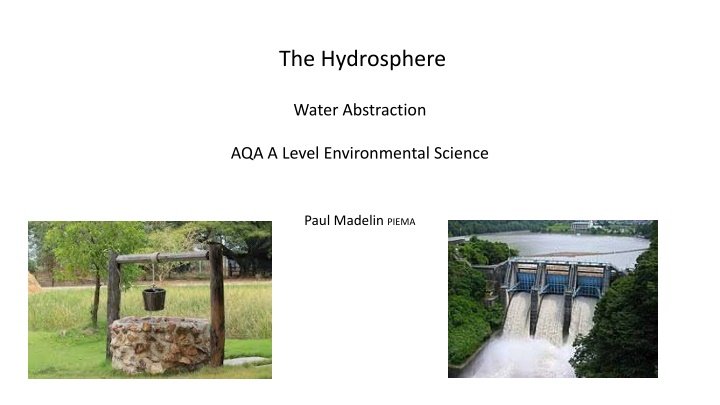
Water Abstraction: Impacts and Processes
Explore the process of water abstraction from natural sources, such as rivers and reservoirs, and its environmental impacts. Discover the consequences on habitats, wildlife, and climate, along with the concept of water residence time in the hydrological cycle.
Download Presentation

Please find below an Image/Link to download the presentation.
The content on the website is provided AS IS for your information and personal use only. It may not be sold, licensed, or shared on other websites without obtaining consent from the author. If you encounter any issues during the download, it is possible that the publisher has removed the file from their server.
You are allowed to download the files provided on this website for personal or commercial use, subject to the condition that they are used lawfully. All files are the property of their respective owners.
The content on the website is provided AS IS for your information and personal use only. It may not be sold, licensed, or shared on other websites without obtaining consent from the author.
E N D
Presentation Transcript
The Hydrosphere Water Abstraction AQA A Level Environmental Science Paul Madelin PIEMA
Water abstraction refers to the process of taking or extracting water from a natural source (rivers, lakes, groundwater aquifers, etc.) for various uses, from drinking to irrigation, treatment, and industrial applications. The creation of a reservoir following the construction of a dam alters the environment. Habitat change From a land habitat to an aquatic one Wildlife barriers Affects migrating fish such as Salmon Change of river flow Slower flow is bad for salmon and trout eggs Build-up of sedimentation (and potentially pollutants) Which would have washed away in a river Creation of new microclimates Warmer in winter, cooler in summer. Higher windspeeds. Greater evaporation leading to increased humidity and precipitation downwind
1. The general name for the storage location of ANY mineral e.g. nitrogen, crude oil, water, iron Reservoir 2. Stored water retained by a dam 1. a natural or artificial place where water is collected and stored for use, especially water for supplying a community, irrigating land, furnishing power, etc. 2. a receptacle or chamber for holding a liquid or fluid. 3. Geology. See under pool 4. Biology. a cavity or part that holds some fluid or secretion. 5. a place where anything is collected or accumulated in great amount. 6. a large or extra supply or stock; reserve; a reservoir of knowledge. Wraysbury Reservoir, west of London
Residence time is a measure of the average time a molecule of water spends in an area of the hydrological cycle (reservoir) Equation E.g. The oceans have a water residence time of 3,000 to 3,230 years. It is equal to the reservoir volume divided by the inflow or outflow rate
Use the equation below. What is the residence time for a river containing 2 x 1015 kg of water. The only significant transfer is by runoff, at 19 x 1015 kg yr-1 52 x 0.11
Using pages 117-121 of your text book, research water abstraction from rivers/reservoirs and aquifers. Use this sheet to collate your notes
